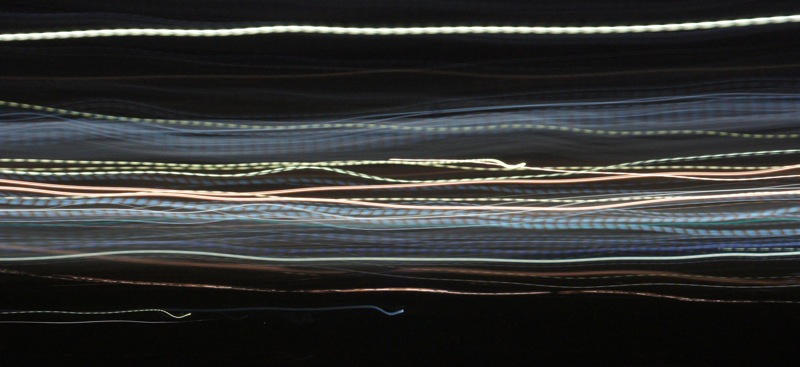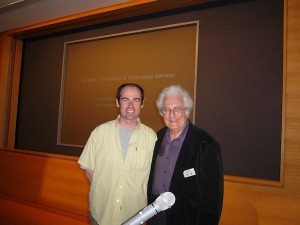Category Archives: Tools
A new way to hurt yourself
It goes without saying that augmented reality eyewear is not without problems. The following spoof of the Google Project Glass video points out some of the obvious ones in a comical fashion.
Project Glass @ Google

Google has posted information about Project Glass. The photos and video show a stylish, lightweight eyeworn see-through display operated via a speech interface, which allows you to do many of the things you already do with your iPhone, but without manual interaction. This announcement has been expected for some time and we mentioned it in an earlier post on HMDs titled Retro-Future. It will be increasingly difficult to justify the purchase of outrageously priced and bulky retro-HMDs when consumer products with superior form-factor and functionality come on to the market. Currently price estimates for the AR eyewear run from $200.00 to $600.00, but this is guessing. No doubt Google will make APIs easily available for the eyewear, so that R&D can be conducted by anyone with modest means and sufficient motivation. The video, available via YouTube, is probably mostly a mock-up and I’m wondering where the battery will be located.
Walking around in Nakanoshima
Here’s a recording I made in Nakanoshima, on February 02, 2012, testing out a windshield for binaural microphones. If you listen with headphones you can hear some of the spatial qualities of the audio.
That’s a situationist yelp close to the beginning when a somewhat rude older couple hogging the sidewalk nearly walked into me. Manners!
The section at the end, a close-up recording of some kind of noisy machine for fixing the road, gives a strong percept of space. Here’s the section by itself:
Use headphones (or, more likely?, earbuds) to hear the binaural effect.
picture of the moon
(click for larger image)
According to the EXIF data this picture of the moon was taken on 2011/11/6 at 20:10 hrs with a SONY NEX-5 and a Leitz Summicron 50mm f/2 lens. The exposure was 13 sec, with the gain set to +2EV at ISO 1600, equivalent to ISO 400. I don’t have a record of the aperture, but it was probably stopped down to prolong the (automatic) exposure. No tripod.
Here are some light paintings made with the same method, but aiming the camera along the horizon to catch photons from shops, cars, and street lamps.
I♥フィルム Pt.II
(click images for larger size)
More film photos, this time taken with a Nikon FM2 and Nikkor 50mm f1.8, a classic camera and lens both of near-legendary quality, and Kodak Gold 400. This film is one of Kodak’s cheapest offerings but, as you can see, there is nothing cheap about the quality. Some of these scenes should be familiar since they were all taken in Kinugasa, not far from campus.
By the way, when are we going to start making life easier for cyclists? Bicycles have the potential to help solve some of the world’s biggest problems.
I♥フィルム
I always bring both film and digital cameras on my travels. This time I brought only my iPhone 4s, Nikon F3 (HP model) and two lenses Nikkor 24mm f2.8 and Nikkor 50mm f2.0 on my trip to Naoshima. I’ve had the 50/2.0 lens since I bought it new in 1977, when I was 15 years old. These pictures were taken using Kodak Portra 160 film (both NC and new types).
The First NIME
The BBC News web site currently has a good article about the Theremin, an electronic instrument invented by Russian Léon Theremin in 1919. Though it was not the first synthesizer, I consider the Theremin to have been the first NIME: earlier electronic synthesizers like the Telharmonium (1897) mainly used keyboard-like controllers. The Theremin, by contrast, is played with non-contact gestures (waving your hands in the air). It is a full blown new electronic instrument, the product of a futurist/modernist outlook and cutting-edge technical mastery (for the day), which opened the potential for completely new forms of human artistic expression.
I am not going to introduce the Theremin here. Better to start by reading the BBC article or Wikipedia entry, both linked above. You can get an idea of how it can be played by watching any number of videos on YouTube. Here’s Léon Theremin’s neice, Lydia Kavina, playing Claude Debussy’s “Clair de Lune”:
The BBC article quotes an interesting statement from Theremin biographer Albert Glinsky which I would like to include here:
RCA felt this was going to replace the parlour piano and anyone who could wave their hands in the air or whistle a tune could make music in their home with this device. The Theremin went on sale in September 1929 at the relatively high price of $220 – a radio set cost about $30. It was also much more difficult to play than the advertising claimed. And just one month later came the Wall Street Crash. You took it home and found that your best efforts led to squealing and moaning sounds. So the combination of the fact that only the most skilled people could teach themselves how to play it and the fact that there was a downturn in the economy meant that the instrument really wasn’t a commercial success
This seems to be a somewhat common story with the most unusual/innovative new music technology – it is difficult to get make significant cultural impact.

The Theremin, however, has had good staying power. It is still a niche instrument with few virtuosi, but you can, in fact, purchase a Theremin and find someone to help you to learn how to make music with it. High quality Theremins are made by Moog Music. As it turns out, electronic instrument pioneer Robert Moog got started by selling Theremin kits while he was still an undergraduate physics student. Moog represents an important link between the earliest NIMEs and contemporary electronic music technology and culture. For this reason we invited Dr. Moog as a Keynote speaker for NIME-04, which was held in Hamamatsu, Japan’s mecca for music technology.
I had the good fortune to invite Dr. Moog to give a talk at the company where I used to work, ATR, in southern Kyoto prefecture. It was a great experience to spend time talking with Dr. Moog and to introduce him to a huge and enthusiastic audience who showed up from all over Japan to hear him speak. I will never forget what a kind-hearted person Bob Moog was.
Vimeo & YouTube HD Informal Comparison
I uploaded the same HD video file (1280×720 progressive) to YouTube and Vimeo. Watch these on full screen, with resolution set to 720p on YouTube and ‘HD Mode’ selected on Vimeo.
Simple P5 Sketch Circle Animation (720p) from Michael Lyons on Vimeo.
This is an unusual video in that it consists only of moving black lines on a pure white background, so compression artifacts are quite noticeable. The raw data (1800 png image files) is over 200MB but artefacts were barely visible in the ~100MB H.264-compressed mp4 file I uploaded to both Vimeo and YouTube. That noted, it seems clear that YouTube has the advantage in terms of quality. Since I’ve read otherwise in informal reports on the web, I’m not sure whether or not the quality might improve with Vimeo Plus, a paid upgrade currently available for the discounted price of US$60/year. Overall, Vimeo offers a calmer, more pleasant user experience than YouTube. The user interface is nicely designed and the online help files are easy to navigate and genuinely helpful. The content and the community are generally more edifying: no denying it there’s a lot of trash on YouTube. The advertising on YouTube is also more obtrusive and distracting. As for pure spec: time to upload and process a video is much quicker with YouTube. Upload is slower with Vimeo and they also make non-paying users wait for at least 30 minutes before the video goes online. Moreover there are weekly limits on total data and only one HD video may be uploaded per week. Third party advertising is less intrusive but lately Vimeo is pushing the paid-subscription fairly hard.
Addendum: Vimeo offers a slightly better experience when browsing from iOS devices in that it’s easier to directly open the 720p viewer. But compression artefacts are still more noticeable, with this file, than with YouTube. Note also that YouTube allows upload of higher resolution videos such as ‘Full HD’ (1080p).
Simple P5 Animation
This is a simple, lightweight P5 sketch captured to a low-res (320×240), compact video just to illustrate that it is easy to create animations with Processing.
Uploaded with Vimeo also, but Vimeo makes non-paying users wait.
Here is the same P5 sketch rendered at 720p (watch full screen):
The lower-resolution video was made using the built-in MovieMaker class. The 720p version was made by saving each frame as a png image file by calling the saveFrame() method. The frames were then concatenated and saved in mp4 format using FFmpeg.
















